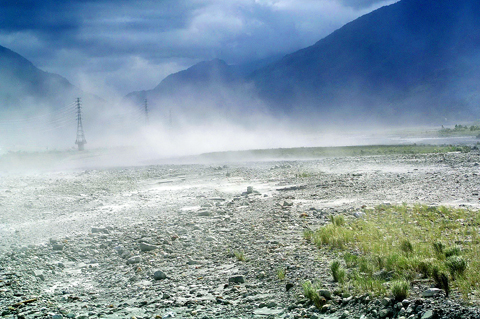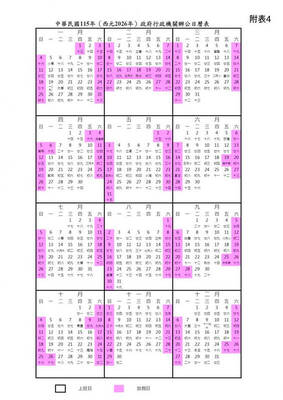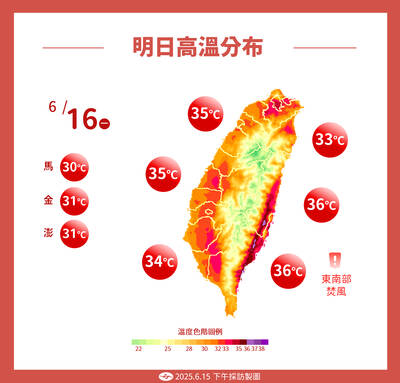After a freak dust storm covered the nation last April, Kaohsiung resident Chan Chia-chun (詹家駿) began donning a mask before riding his scooter to a nearby marketplace every morning.
The windblown dust storms that originate in the deserts of China and make their way to Taiwan every spring are widely blamed for sore throats, skin problems and respiratory failure, health experts say.
The dust storms have become such a problem that the Environmental Protection Administration (EPA) set up a monitoring Web site last November to track them and give members of the public a look at long-term trends.

PHOTO: YU TAI-LANG, TAIPEI TIMES
However, dust storms are not only becoming an increasingly potent — and uncontrollable — problem from abroad. In Taiwan itself, dry river beds and diminishing riverside forests are also leading to a gradual increase in the frequency and force of dust storms whipped up locally, experts say.
Parts of Taisi (台西) and Lunbei (崙背) townships in Yunlin County were coated last November by a dust storm that EPA monitoring stations found contained particle densities between 1,000 and 2,500 micrograms per square meter, which far exceeded standards set by health authorities.
They deem densities above 150 to be detrimental to human health and amounts above 420 to be dangerous.
It has become such a problem, especially in recent years, that some townships advise elementary school students to stay home sometimes between November and March when prevailing northeast winds blow loose sand from dry riverbeds, creating dust storms.
The trouble is especially noticeable in central Taiwan along the Da-an (大安溪), Dajia (大甲溪) and Jhuoshuei (濁水溪) rivers, as well as in Taitung County beside the Beinan River (卑南溪) because of its drier climate and changes to water flow patterns caused by Typhoon Morakot last August, researchers say.
Lawmakers have been trying, some say unsuccessfully, to rectify the problem.
During the last legislative session, Democratic Progressive Party Legislator Liu Chien-kuo (劉建國) proposed an amendment to the Disaster Prevention and Protection Act (災害防救法) to add dust storms to the list of “natural” disasters. Legislators have also tried to introduce subsidies for crop damage caused by the storms.
Many of these efforts are trying to mitigate the issue, not solve the root causes, researchers said. They said that to tackle the problem, solutions have to reach below the ground — to a lack of foliage and dwindling water supplies.
“It’s a complicated problem,” said Yeh Chi-hui (葉啟輝), a professor of environmental engineering at Da Yeh University. “There are many factors involved … and for many of [them], not a lot of data has been gathered.”
Data from Yunlin County’s Environmental Bureau shows the frequency of dust storms has been slowly increasing over the past few years, but many researchers said there have not been enough government studies into the causes and effects of the dust storms.
Yeh said many farmers and local officials do not realize that the problem is growing, despite the statistics showing the increase.
Many farmers continue to grow their watermelon crops beside rivers — some legally, others illegally — causing uplifted and loose soil, especially before planting season in January and February.
Deforestation is another major issue as forests have gradually been cut back to make room for agricultural plantations, reducing wind cover and allowing larger gusts to pick up loose soil particles, Yeh said.
Then there are the water problems. Less water has been flowing into riverbanks, which results in more uncovered riverbeds, leaving more soil vulnerable to wind gusts, Yeh said.
Some local politicians and farming associations have long blamed big factories for the lack of water and receding river levels.
These are problems that will have to be dealt with quickly as the dust particles contain heavy amounts of metals and minerals, which can quickly damage the human body, said Kuo Chung-yih (郭崇義), a professor at Chung Shan Medical University who specializes in environmental science.
Kuo’s research has found that long-term exposure to larger particles of 10 micrometers or less in diameter could result in breathing and liver problems and could later lead to heart and artery complications.
The danger is clear, he said, but “nobody has fixed the problem.”
There are some encouraging signs.
Officials at a public hearing at the legislature late last month promised to study the possibility of providing free health checks for everyone living near four rivers in Yunlin, Taichung and Taitung counties.
The results would be used to evaluate the local dust storm problem and could be used to jumpstart initiatives to rectify the problem.
Environmental Protection Administration Minister Stephen Shen (沈世宏) has assigned a task force to evaluate the problem.
“In the agency’s view… fixing this problem would be even more important to health checks … We are going to do our best to look for solutions,” Shen told the hearing.
Air Quality Protection and Noise Control head Hsieh Yen-ju (謝燕儒) said environmental officials would work with local governments to plant more foliage in riverbank areas and increase the number of monitoring stations.
Some critics said the EPA is taking a Band-Aid approach to solving the problem, but others were more optimistic.
Local officials and county councilors said after the hearing they were glad the government was willing to address the problem and that many of their constituents could finally breathe a sigh of relief.

Taiwan is to have nine extended holidays next year, led by a nine-day Lunar New Year break, the Cabinet announced yesterday. The nine-day Lunar New Year holiday next year matches the length of this year’s holiday, which featured six extended holidays. The increase in extended holidays is due to the Act on the Implementation of Commemorative and Festival Holidays (紀念日及節日實施條例), which was passed early last month with support from the opposition Chinese Nationalist Party (KMT) and Taiwan People’s Party. Under the new act, the day before Lunar New Year’s Eve is also a national holiday, and Labor Day would no longer be limited

Taiwan is to extend its visa-waiver program for Philippine passport holders for another year, starting on Aug. 1, Minister of Foreign Affairs Lin Chia-lung (林佳龍) said on Friday. Lin made the announcement during a reception in Taipei marking the 127th anniversary of Philippine independence and the 50th anniversary of the establishment of the Manila Economic and Cultural Office (MECO) in Taiwan, the Ministry of Foreign Affairs said. The decision reflected Taiwan’s commitment to deepening exchanges with the Philippines, the statement cited Lin as saying, adding that it was a key partner under the New Southbound Policy launched in 2016. Lin also expressed hope

Costa Rica sent a group of intelligence officials to Taiwan for a short-term training program, the first time the Central American country has done so since the countries ended official diplomatic relations in 2007, a Costa Rican media outlet reported last week. Five officials from the Costa Rican Directorate of Intelligence and Security last month spent 23 days in Taipei undergoing a series of training sessions focused on national security, La Nacion reported on Friday, quoting unnamed sources. The Costa Rican government has not confirmed the report. The Chinese embassy in Costa Rica protested the news, saying in a statement issued the same

Temperatures in New Taipei City’s Sindian District (新店) climbed past 37°C yesterday, as the Central Weather Administration (CWA) issued heat alerts for 16 municipalities, warning the public of intense heat expected across Taiwan. The hottest location in Taiwan was in Sindian, where the mercury reached 37.5°C at about 2pm, according to CWA data. Taipei’s Shilin District (士林) recorded a temperature of 37.4°C at noon, Taitung County’s Jinfeng Township (金峰) at 12:50 pm logged a temperature of 37.4°C and Miaoli County’s Toufen Township (頭份) reached 36.7°C at 11:40am, the CWA said. The weather agency yesterday issued a yellow level information notice for Taipei, New